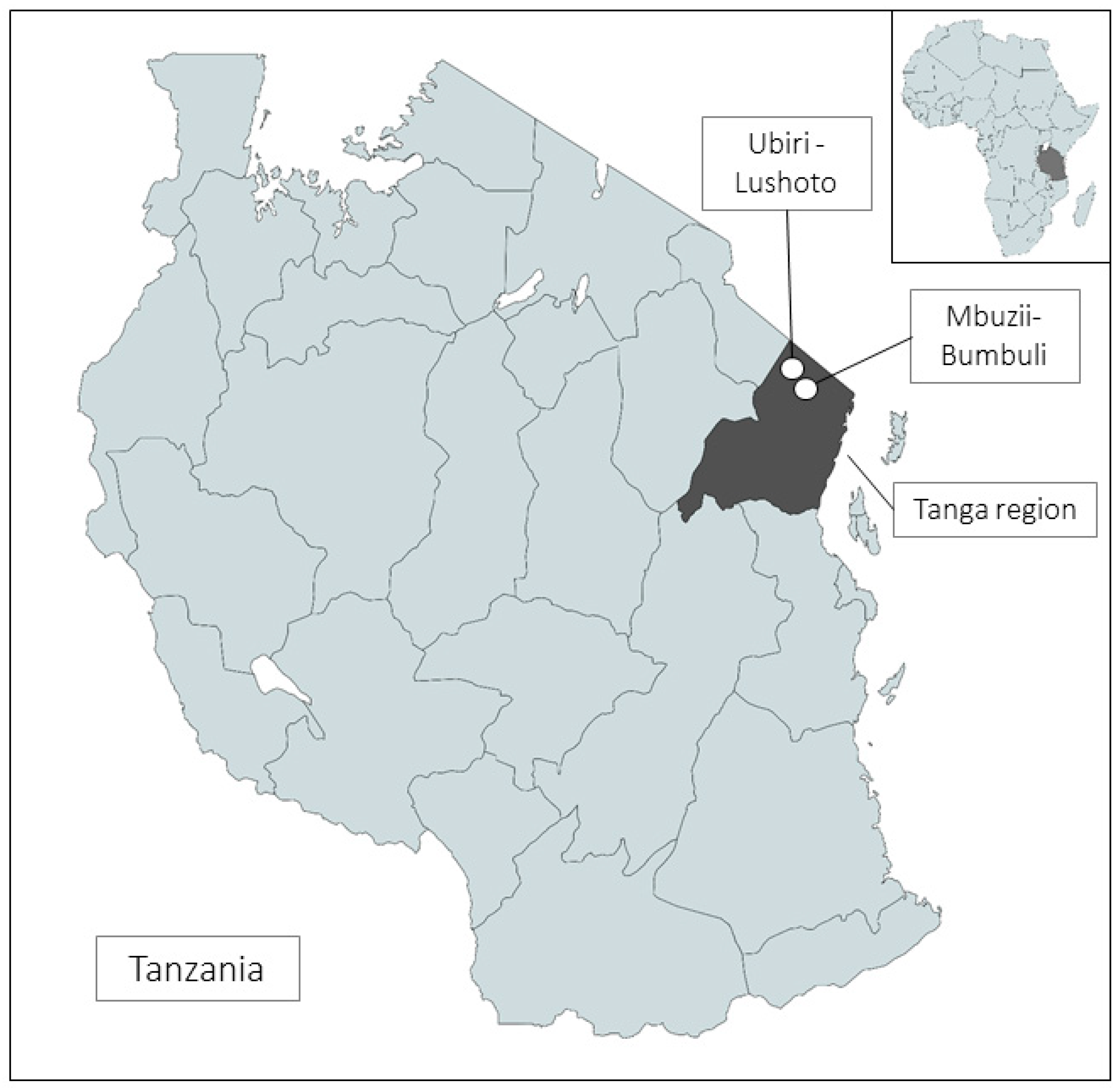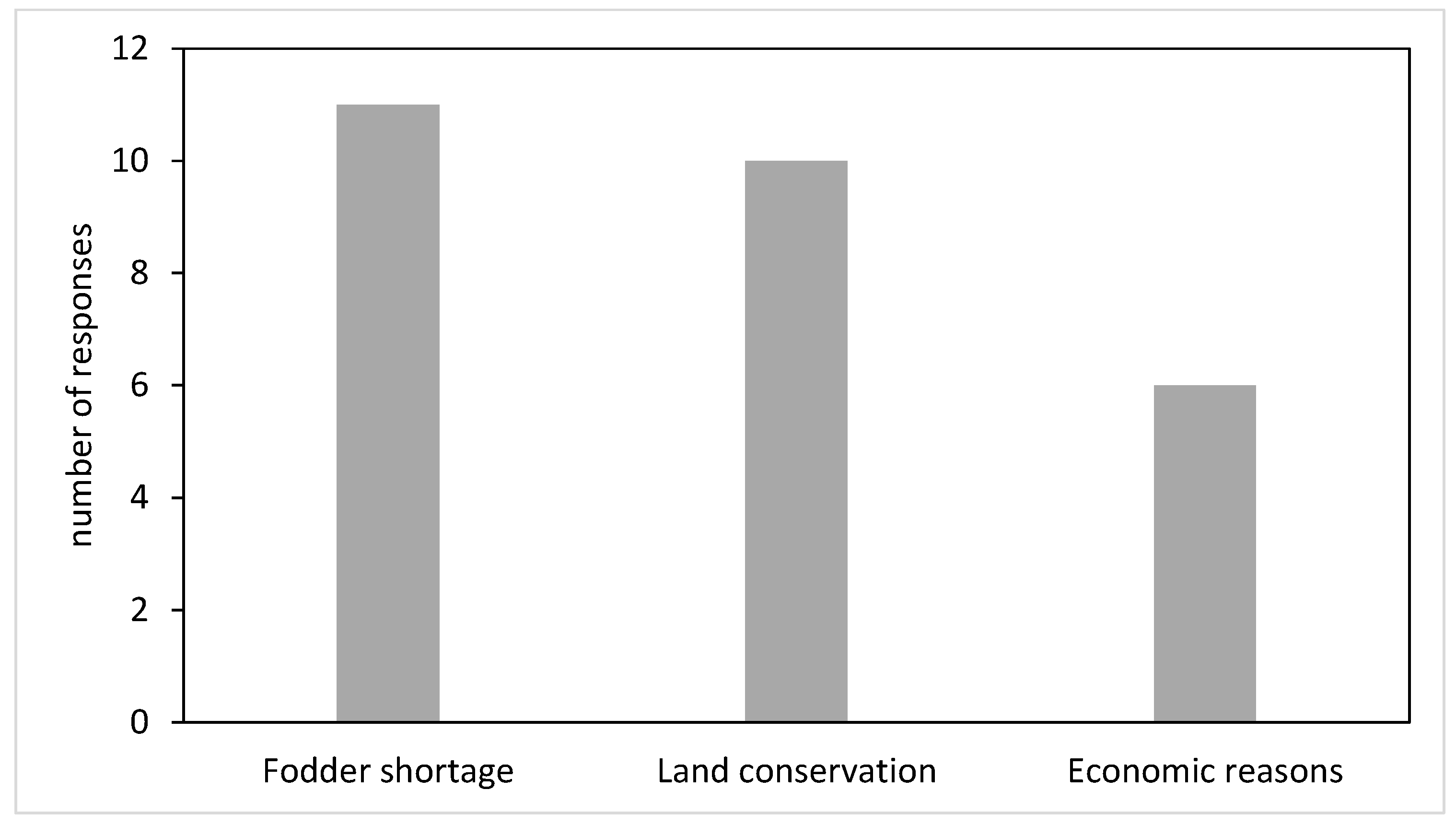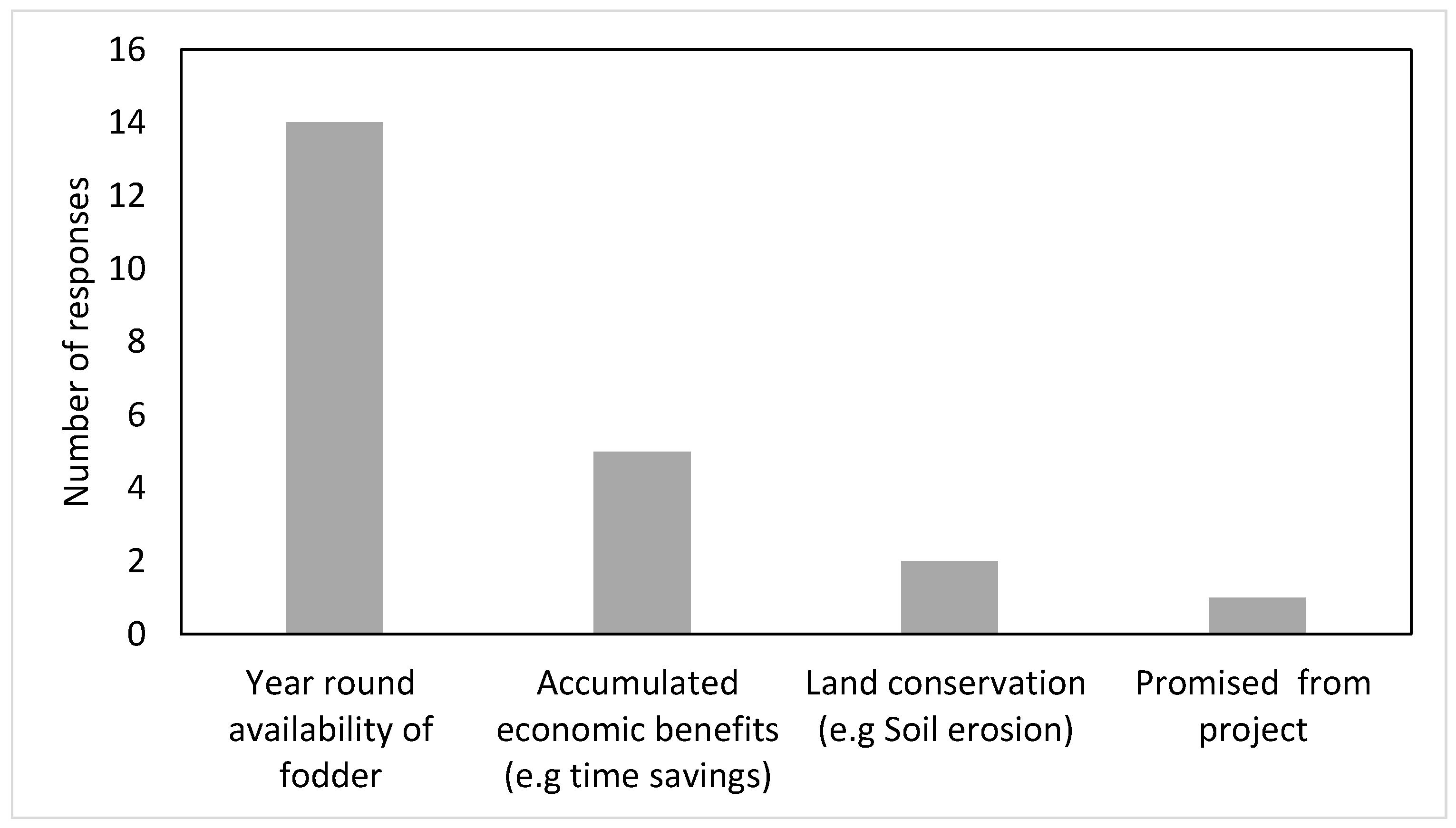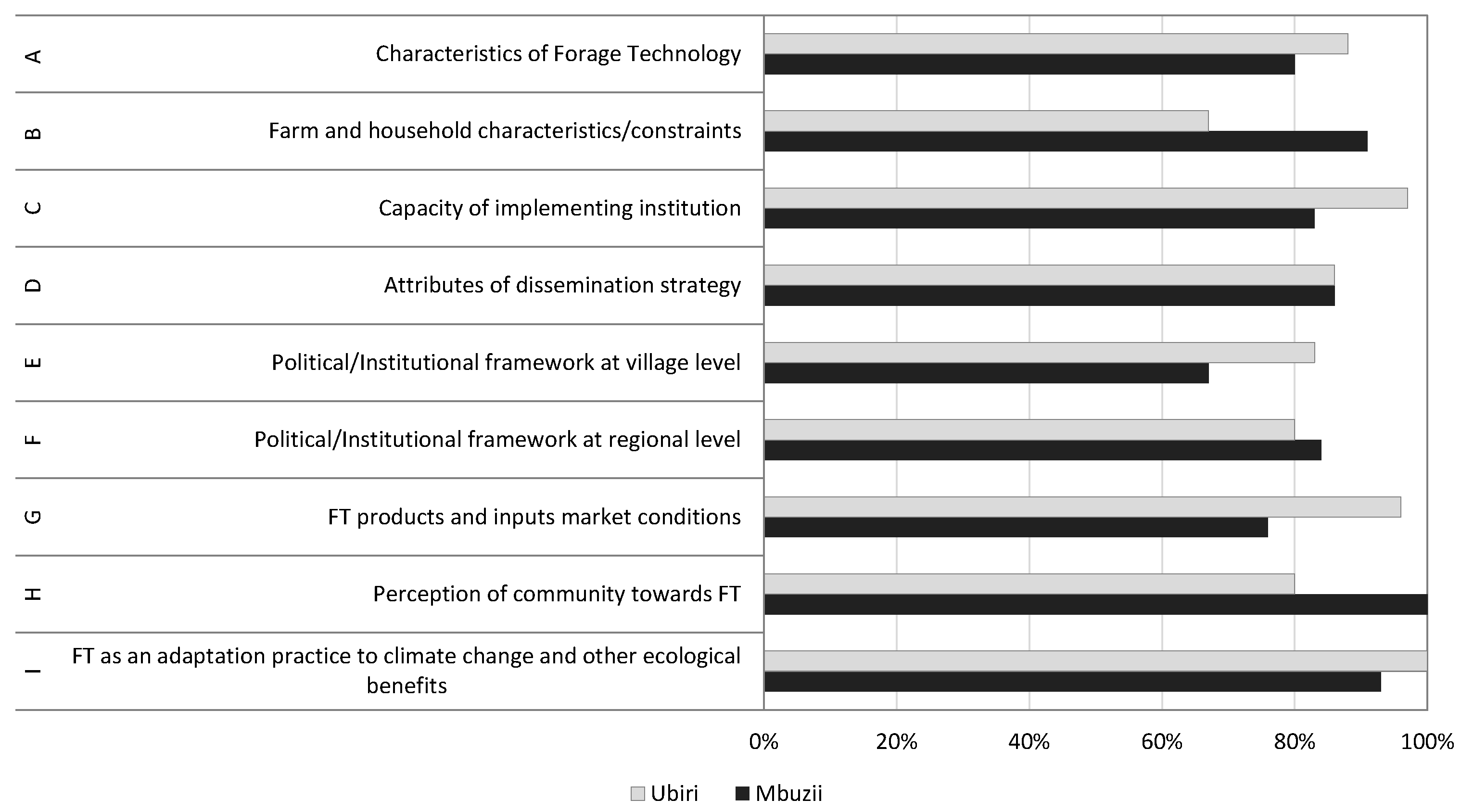Determinants for Smallholder Farmers’ Adoption of Improved Forages in Dairy Production Systems: The Case of Tanga Region, Tanzania
Abstract
:1. Introduction
2. Materials and Methods
2.1. Conceptual Basis
2.2. Methods
2.2.1. Field Visits and Interviews
- What was the source of first knowledge on improved forage technologies?
- What was the year of this first knowledge?
- What was the actual starting year, e.g., first planting of materials?
- What reasons made you start? (trigger)
- What reasons keep you going on? (supporting forces)
- At what point did you feel uncomfortable, and if so why? (inhibiting forces)
- What recommendations do you have towards the further improvement of this technology as a farmer?
2.2.2. Qualitative Assessment Tool for Forage Technologies
- 0 = not sure, has no positive effect on adoption likelihood (even negative);
- 1 = strongly disagree, has a limited positive effect on adoption;
- 2 = disagree;
- 3 = partly agree;
- 4 = agree;
- 5 = strongly agree, has a maximum positive influence on adoption likelihood;
- N = if you think, the statement is not applicable in this case or appropriate.
2.3. Case Study Data
3. Results
3.1. Findings from Interviews and Field Visits
3.1.1. Main Triggering Factors to Initial Adoption
3.1.2. Forage Production
3.1.3. Organisational Issues within the Farm and Village Context
3.1.4. Summary Findings on Interviews and Field Visits
3.2. Findings from QATo-FT Assessment
3.2.1. Adoption Potential
3.2.2. Specific Supporting and Hindering Factors
4. Discussion
5. Conclusions
Supplementary Materials
Author Contributions
Funding
Institutional Review Board Statement
Informed Consent Statement
Data Availability Statement
Acknowledgments
Conflicts of Interest
References
- Ndambi, O.A.; Hemme, T.; Latacz-Lohmann, U. Dairying in Africa-Status and recent developments. Livest. Res. Rural. Dev. 2007, 19, 25. [Google Scholar]
- Otte, M.J.; Chilonda, P.C.; Ruminant, S. Production Systems in Sub-Saharan Africa: A systematic Review; Food and Agriculture Organization of the United Nations: Rome, Italy, 2002. [Google Scholar]
- Jahnke, H.E.; Tacher, G.; Keil, P.; Rojat, D. Livestock Production in Tropical Africa, with Special Reference to the Tsetse-Affected Zone. In Livestock Production in Tsetse-Affected Areas of Africa, Nairobi, Kenya, 1987; International Livestock Centre for Africa and the International Laboratory for Research on Animal Diseases: Nairobi, Kenya, 1987; pp. 3–21. [Google Scholar]
- Zamani, O.; Pelikan, J.; Schott, J. EU Exports of Livestock Products to West Africa: An Analysis of Dairy and Poultry Trade Data; Thünen Working Paper; Thünen-Institut: Braunschweig, Germany, 2021. [Google Scholar]
- Smith, J.; Tarawali, S.; Grace, D.; Sones, K. Feeding the World in 2050: Trade-offs, synergies and tough choices for the livestock sector. Trop. Grasslands-Forrajes Trop. 2013, 1, 125. [Google Scholar] [CrossRef] [Green Version]
- Lukuyu, B.; Kitalyi, A.; Franzel, S.; Duncan, A.; Baltenweck, I. Constraints and Options to Enhancing Production of High Quality Feeds in Dairy Production in Kenya, Uganda and Rwanda ICRAF Working Paper No. 95; Center for International Forestry Research (CIFOR) and World Agroforestry Centre (ICRAF): Nairobi, Kenya, 2009. [Google Scholar]
- Alexandratos, N.; Bruinsma, J. World Agriculture towards 2030/2050: The 2012 Revision; ESA Working Paper No. 12-03; FAO: Rome, Italy, 2012. [Google Scholar]
- Gillah, K.A.; Kifaro, G.C.; Madsen, J. Urban and peri urban dairy farming in East Africa: A review on production levels, constraints and opportunities. Livest. Res. Rural. Dev. 2012, 24, 198. [Google Scholar]
- Sumberg, J. Constraints to the adoption of agricultural innovations: Is it time for a re-think? Outlook Agric. 2005, 34, 7–10. [Google Scholar] [CrossRef]
- Njarui, D.M.G.; Kabirizi, J.M.; Itabari, J.K.; Gatheru, M.; Nakiganda, A.; Mugerwa, S. Production characteristics and gender roles in dairy farming in peri-urban areas of Eastern and Central Africa. Livest. Res. Rural. Dev. 2012, 24, 2012. [Google Scholar]
- Wambugu, C.; Place, F.; Franzel, S. Research, development and scaling-up the adoption of fodder shrub innovations in East Africa. Int. J. Agric. Sustain. 2011, 9, 100–109. [Google Scholar] [CrossRef]
- Franzel, S.; Wambugu, C. The uptake of fodder shrubs among smallholders in East Africa: Key elements that facilitate widespread adoption. In Forages: A Pathway to Prosperity for Smallholder Farmers, Thailand, 2007; Hare, M.D., Wongpichet, K., Eds.; Ubon Ratchathani University: Ubon Ratchathani, Thailand, 2007; pp. 203–222. [Google Scholar]
- Ngwira, A. Forage demand and constraints to adoption of forage technologies by livestock keepers in Malawi. Trop. Grassl. 2003, 37, 274–278. [Google Scholar]
- Gebremedhin, B.; Ahmed, M.M.; Ehui, S.K. Determinants of adoption of improved forage technologies in crop-livestock mixed systems: Evidence from the highlands of Ethiopia. Trop. Grassl. 2003, 37, 262–273. [Google Scholar]
- Mwangi, D.M.; Wambugu, C. Adoption of forage legumes: The case of Desmodium, intortum and Calliandra, calothyrsus in central Kenya. Trop. Grassl. 2003, 37, 227–238. [Google Scholar]
- Ndah, H.T.; Schuler, J.; Nkwain, V.N.; Nzogela, B.; Mangesho, W.E.; Mollel, R.; Loina, R.; Paul, B.K. Factors Affecting the Adoption of Forage Technologies in Smallholder Dairy Production Systems in Lushoto, Tanzania; CIAT Working Paper; CIAT: Cali, Columbia, 2017. [Google Scholar]
- Ndah, H.T.; Knierim, A.; Ndambi, O.A. Fish Pond Aquaculture in Cameroon: A Field Survey of Determinants for Farmers’ Adoption Behaviour. J. Agric. Educ. Ext. 2011, 17, 309–323. [Google Scholar] [CrossRef]
- Rogers, E.M. Diffusion of Innovation; The Free Press: New York, NY, USA, 1995. [Google Scholar]
- Straub, E.T. Understanding Technology Adoption: Theory and Future Directions for Informal Learning. Rev. Educ. Res. 2009, 79, 625–649. [Google Scholar] [CrossRef] [Green Version]
- Ndah, H.T.; Schuler, J.; Uthes, S.; Zander, P.; Triomphe, B.; Mkomwa, S.; Corbeels, M. Adoption Potential for Conservation Agriculture in Africa: A Newly Developed Assessment Approach (QAToCA) Applied in Kenya and Tanzania. Land Degrad. Dev. 2015, 26, 133–141. [Google Scholar] [CrossRef]
- Adesina, A.A.; Baidu-Forson, J. Farmers’ perceptions and adoption of new agricultural technology: Evidence from analysis in Burkina Faso and Guinea, West Africa. Agric. Econ. 1995, 13, 1–9. [Google Scholar] [CrossRef]
- Fowler, R.; Rockstrom, J. Conservation tillage for sustainable agriculture: An agrarian revolution gathers momentum in Africa. Soil Tillage Res. 2001, 61, 93–108. [Google Scholar] [CrossRef]
- Habtemariam, L.T.; Gandorfer, M.; Kassa, G.A.; Sieber, S. Risk experience and smallholder farmers’ climate change adaptation decision. Clim. Dev. 2019, 12, 385–393. [Google Scholar] [CrossRef]
- Hansen, J.; Hellin, J.; Rosenstock, T.; Fisher, E.; Cairns, J.; Stirling, C.; Lamanna, C.; van Etten, J.; Rose, A.; Campbell, B. Climate risk management and rural poverty reduction. Agric. Syst. 2018, 172, 28–46. [Google Scholar] [CrossRef]
- Probst, L.; Ndah, H.T.; Rodrigues, P.; Basch, G.; Coulibaly, K.; Schuler, J. From adoption potential to Transformative Learning around Conservation Agriculture. J. Agric. Educ. Ext. 2018, 25, 25–45. [Google Scholar] [CrossRef]
- Paul, B.K.; Groot, J.C.; Maass, B.L.; Notenbaert, A.M.; Herrero, M.; A Tittonell, P. Improved feeding and forages at a crossroads: Farming systems approaches for sustainable livestock development in East Africa. Outlook Agric. 2020, 49, 13–20. [Google Scholar] [CrossRef]




| Code | Thematic Areas of the Tool |
|---|---|
| A | Characteristics of forage technology (object of adoption) |
| B | Farm and household characteristics/constraints |
| C | Capacity of implementing institution |
| D | Attributes of dissemination strategy |
| E | Political/institutional framework at village level |
| F | Political/institutional framework at regional level |
| G | FT products and inputs market conditions |
| H | Perception of community towards FT |
| I | FT as an adaptation practice to climate change and other ecological benefits |
| Village | Weak Hindering Factors | Strong Hindering Factors |
|---|---|---|
| Mbuzii-Bumbuli | Household labour is usually sufficient to implement FT (A2) The local government promotes FT adoption through extension programmes (E3) | The promoting organisation promotes FT through mass media, such as radio, TV or newspapers (D9) There exist decentralised structures within the administration, which allow locally adapted and timely solutions to farmers′ problems (E5) There is a local government with strong leadership that commits itself to development objectives (F1) |
| Ubiri-Lushoto | The majority of farmers have knowledge of FT or traditional/indigenous knowledge similar to FT (B2) Young farmers are willing to participate in FT project activities, and FT practice creates employment opportunities for them (H3) | The promoting organisation promotes FT through mass media, such as radio, TV or newspapers (D9) The settlement pattern allows extension officers easy access to farmers for promotional purposes (F5) |
| Domains | Specific Activities |
|---|---|
| Knowledge transfer | Sensitisation and education of farmers on short and long term benefits of introduced forage technologies towards general livestock production, increased milk yield and soil conservation, alongside other ecological benefits. |
| Administrative | Ensure the existence of decentralised structures within the administration, which allow for locally adapted and timely solutions to the farmers′ problems. Allocate a budget for extension officers to be able to move around the farmers and attend to the farmers’ needs. Form and strengthen solid partnerships between local governments, farmers, NGOs, service providers, extension officers and all other beneficial networks around the practice of improved forages beyond the present existing innovation platforms in the region. Organise easy access to basic resources, such as water at the community level, to serve the farmers, especially in dry seasons. |
| Economic | Improve off-farm income possibilities to reduce pressure on land use as the only income source. Create access to the existing markets to encourage the mass production of milk from farmers, which will consequently trigger their adoption of improved forages, e.g., establishing more local collection centres endowed with small milk cooling facilities with the possibility of direct pick up at the farm gate to increase the farmers′ profit margins. |
| Agronomic | Carry out a proper assessment of new improved forage technologies′ resilience and resistance to local and possible changing climatic factors of the region. Improve the issue of accessibility to seeds or planting material for potential adopter farmers who have become convinced of the stimulating effect of improved forages on their milk yield levels, e.g., the accessibility to planting materials should not be limited only to members of the innovation platforms, but open even to non-members who show an interest. |
Publisher’s Note: MDPI stays neutral with regard to jurisdictional claims in published maps and institutional affiliations. |
© 2022 by the authors. Licensee MDPI, Basel, Switzerland. This article is an open access article distributed under the terms and conditions of the Creative Commons Attribution (CC BY) license (https://creativecommons.org/licenses/by/4.0/).
Share and Cite
Ndah, H.T.; Schuler, J.; Nkwain, V.N.; Nzogela, B.; Mangesho, W.; Mollel, R.; Loina, R.; Zander, P.; Paul, B.K. Determinants for Smallholder Farmers’ Adoption of Improved Forages in Dairy Production Systems: The Case of Tanga Region, Tanzania. Agronomy 2022, 12, 305. https://doi.org/10.3390/agronomy12020305
Ndah HT, Schuler J, Nkwain VN, Nzogela B, Mangesho W, Mollel R, Loina R, Zander P, Paul BK. Determinants for Smallholder Farmers’ Adoption of Improved Forages in Dairy Production Systems: The Case of Tanga Region, Tanzania. Agronomy. 2022; 12(2):305. https://doi.org/10.3390/agronomy12020305
Chicago/Turabian StyleNdah, Hycenth Tim, Johannes Schuler, Vandoline N. Nkwain, Beatus Nzogela, Walter Mangesho, Richard Mollel, Rose Loina, Peter Zander, and Birthe K. Paul. 2022. "Determinants for Smallholder Farmers’ Adoption of Improved Forages in Dairy Production Systems: The Case of Tanga Region, Tanzania" Agronomy 12, no. 2: 305. https://doi.org/10.3390/agronomy12020305
APA StyleNdah, H. T., Schuler, J., Nkwain, V. N., Nzogela, B., Mangesho, W., Mollel, R., Loina, R., Zander, P., & Paul, B. K. (2022). Determinants for Smallholder Farmers’ Adoption of Improved Forages in Dairy Production Systems: The Case of Tanga Region, Tanzania. Agronomy, 12(2), 305. https://doi.org/10.3390/agronomy12020305







